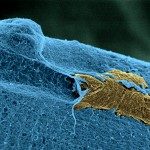Lien vers Pubmed [PMID] – 25344673
Results Probl Cell Differ 2015;56:215-35
The skeletal muscle of vertebrates has a huge regenerative capacity. When destroyed after different types of injury, this organ can regenerate very quickly (less than 20 days following myotoxin injection in the mouse) ad integrum and repeatedly. The cell responsible for this regeneration is the so-called satellite cell, the muscle stem cell that lies on top of the muscle fibre, a giant, multinucleated cell that contains the contractile material. When injected in the muscle, satellite cells can efficiently differentiate into contractile muscle fibres. The satellite cell shows great therapeutic potential; and its regenerative capacity has triggered particular interest in the field of muscular degeneration. In this review we will focus on one particular property of the satellite cell: its quiescence and dormancy. Indeed adult satellite cells are quiescent; they lie between the basal lamina and the basement membrane of the muscle fibre, ready to proliferate, and fuse in order to regenerate myofibers upon injury. It has recently been shown that a subpopulation of satellite cells is able to enter dormancy in human and mice cadavers. Dormancy is defined by a low metabolic state, low mobility, and a long lag before division when plated in vitro, compared to quiescent cells. This definition is also based on current knowledge about long-term hematopoietic stem cells, a subpopulation of stem cells that are described as dormant based on the same criteria (rare division and low metabolism when compared to progeny which are dividing more often). In the first part of this review, we will provide a description of satellite cells which addresses their quiescent state. We will then focus on the uneven distribution of satellite cells in the muscle and describe evidence that suggests that their dormancy differs from one muscle to the next and that one should be cautious when making generalisations regarding this cellular state. In a second part, we will discuss the transition between active dividing cells in developing animals to quiescence. This mechanism could be used or amplified in the switch from quiescence to dormancy. In a third part, we will review the signals and dynamics that actively maintain the satellite cell quiescent. The in-depth understanding of these mechanisms is key to describing how dormancy relies on quiescent state of the cells. In a fourth part, we will deal with dormancy per se: how dormant satellite cells can be obtained, their characteristics, their metabolic profile, and their molecular signature as compared to quiescent cells. Here, we will highlight one of the most important recent findings: that quiescence is a prerequisite for the entry of the satellite cell into dormancy. Since dormancy is a newly discovered phenomenon, we will review the mechanisms responsible for quiescence and activation, as these two cellular states are better known and key to understanding satellite cell dormancy. This will allow us to describe dormancy and its prerequisites.
